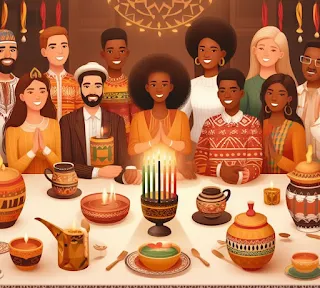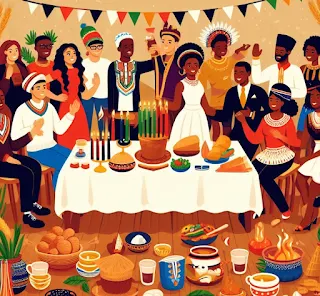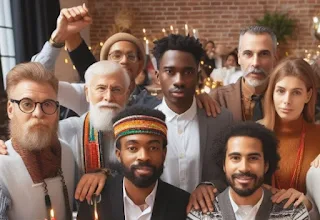Kwanzaa Goes Beyond Race and Religion
Celebrate Kwanzaa if you believe in unity, self-determination, collective work and responsibility, cooperative economics, purpose, creativity, and faith.
Each day of Kwanzaa, with its distinct principle, encourages people of all races, faiths, cultures, and ethnic backgrounds to come together to celebrate shared values, family, community, and culture. Kwanzaa originates in Swahili, specifically from matunda ya kwanza, which translates to first fruits.
Kwanzaa emphasizes the vital role of farming in sustaining communities. The first fruits represent the culmination of collective agricultural efforts, symbolizing abundance, nourishment, and the shared responsibility of cultivating and preserving the land. The term encapsulates the spirit of gratitude, unity, and communal prosperity that defines the core values of Kwanzaa.
Everyone Can and Does Celebrate Kwanzaa
Who typically observes Kwanzaa? Well, the answer is everyone. It is a myth that only black Christian Americans celebrate Kwanzaa. Kwanzaa is unbound by region, race, and religion, celebrating the human race with its core values of unity, responsibility, and faith.
With its universal principles, Kwanzaa becomes a bridge that connects people of different races to celebrate, reflect, and contribute to the shared values of family, community, and culture.
Muslims celebrate Kwanzaa, Buddhists celebrate Kwanzaa, and Christians celebrate Kwanzaa. The followers of Judaism and Hinduism celebrate Kwanzaa. Spiritualists and agnostics celebrate Kwanzaa. Kwanzaa is unbound by religion; it goes beyond religious beliefs.
Kwanzaa strongly emphasizes building a resilient community, fostering self-sufficiency, and nurturing future generations. It encourages all individuals to work together to create a better future for themselves and those around them.
It is a joyful expression of commitment to building a harmonious and purposeful life, grounded in the rich cultural tapestry represented by each of Kwanzaa's seven principles meant to help you start the New Year off right. During the seven days from December 26 to January 1, Kwanzaa is celebrated to honor community, family, and culture.
Kwanzaa's Universal Spirit is a Celebration Unbounded by Race
Explanation of Kwanzaa's universal seven principles.
Day One is Umoja (oo-MO-jah) meaning Unity.
The principle of Umoja invites people from diverse racial backgrounds to unite to acknowledge a shared humanity. It emphasizes the strength found in the collective, fostering bonds that go beyond racial distinctions.
Day Two is Kujichagulia (koo-jee-chah-GOO-lee-ah) meaning Self-Determination.
Kujichagulia encourages individuals of all races to define their paths and embrace self-empowerment. It's a celebration of personal agency, inviting people from various backgrounds to recognize and honor their unique identities.
Day Three is Ujima (oo-jah-MAH) meaning Collective Work and Responsibility.
Ujima underscores the importance of collaboration. This principle encourages individuals of different races to work together, share responsibilities, and contribute collectively to the betterment of their communities.
Day Four is Ujamaa (U-jay-ma) meaning Cooperative Economics.
Ujamaa highlights the mutual support needed for economic empowerment. People of different races can participate in economic cooperation, fostering a sense of shared prosperity and sustainable community development.
Day Five is Nia (NEE-ah) meaning Purpose.
Nia invites individuals of all races to reflect on their collective purpose. It encourages a shared commitment to meaningful goals that benefit individual communities and the broader human family.
Day Six is Kuumba (koo-OOM-bah) meaning Creativity.
Kuumba transcends racial boundaries. It encourages people from all backgrounds to express their unique creativity, contributing to a rich cultural tapestry that reflects the diversity of the global community.
Day seven is Imani (ee-MAH-nee) meaning Faith.
Imani goes beyond religious beliefs. It encourages people of different faiths, cultures, and ethnicities to have faith in each other, fostering trust and a shared commitment to building a harmonious world.
If Kwanzaa is a celebration unbound by race, why are the candles black, green, and red?
Kwanzaa's essence is a celebration transcending racial boundaries; the choice of black, green, and red candles holds cultural and symbolic significance. The black candle represents the principle of Umoja, meaning Unity, and symbolizes the people. The red candle signifies the struggle and resilience throughout history, reflecting the principle of Kujichagulia, or Self-Determination. Lastly, the green candle embodies hope and prosperity for the future, representing the principle of Ujamaa, or Cooperative Economics.
These colors, integral to Kwanzaa, serve as a visual reminder of the global community's shared values and collective experiences, emphasizing unity, self-determination, and cooperative effort, irrespective of racial distinctions.

Lighting the Kwanzaa Candles How to and Meanings
The lighting of the candles takes place on each day of Kwanzaa. The central black candle is lit first on the initial day, representing Umoja (Unity). Subsequently, additional candles are lit from left to right on each consecutive day, alternating between red and green to represent the remaining principles of Kujichagulia, Ujima, Ujamaa, Nia, Kuumba, and Imani. This lighting ceremony is accompanied by discussions, reflections, and expressions of how each principle is relevant to the community.
Lighting the candles during Kwanzaa holds symbolic significance, representing the illumination of the principles and values associated with each day of the celebration. Lighting the candles is a ceremonial and intentional way to focus on the seven principles of Kwanzaa, known as the Nguzo Saba.
Lighting the candles in the Kinara during Kwanzaa is a powerful ritual, creating a tangible representation of the values and principles that form the foundation of this cultural celebration. With its universal principles, Kwanzaa becomes a bridge connecting people of different races to celebrate, reflect on, and contribute to the shared values of family, community, and culture.
It serves as a reminder that celebrating these seven principles: unity, self-determination, collective work and responsibility, cooperative economics, purpose, creativity, and faith transcends racial and cultural boundaries, fostering unity and understanding among diverse communities worldwide.
Each item placed on the table holds a special symbolic significance during the Kwanzaa celebration.
The Table a Ceremonial Space
The table is a physical structure and a meaningful and intentional space. The table serves as the central space where the symbolic items and elements of the celebration are arranged, creating a visual representation of the principles and values of Kwanzaa.
Mat or Mkeka
The mat serves as the foundation for the other symbols on the Kwanzaa table, symbolizing the historical and cultural foundation on which the African heritage and traditions rest. It represents the collective history and ancestry of the community.
Seven Holed Candle Holder or Kinara
The kinara is a candle holder designed with seven holders. Each holder corresponds to one of the seven principles of Kwanzaa, known as the Nguzo Saba. The kinara symbolizes the family and community's collective past, present, and future.
Unity Cup or Kikombe cha Umoja
The unity cup is used to pour libations during the Kwanzaa ceremony. Libations are a way of honoring ancestors and invoking the presence of the divine. Participants take turns sipping from the cup as a gesture of communal unity.
Corn or Muhindi
The corn, typically two ears, represents the children of the family. It symbolizes the potential and promise inherent in the younger generation. Placing the corn on the table underscores the importance of nurturing and investing in the well-being and future success of the youth.
Fruits or Mazao
Fruits, often a selection of fresh and harvested produce, represent the rewards of collective labor and the abundance of working together. The fruits symbolize the productivity and prosperity achieved through unity, cooperation, and shared efforts within the community.
Gifts or Zawadi
Kwanzaa often involves the exchange of zawadi, or gifts, to encourage mutual appreciation and reinforce commitments to shared principles. These gifts, usually educational or culturally significant, are given to children and loved ones.
Did you know?
One of the oldest inclusive Kwanzaa celebrations is held in Delray Beach, Florida, at the Spady Museum. The Kwanzaa Celebration is hosted by Spady Cultural Heritage Museum, Inc. in collaboration with the Zeta Phi Beta Sorority, Inc., the Sankofa Study Group, Pyramid Books, and Kwanzaa 365 Live.







